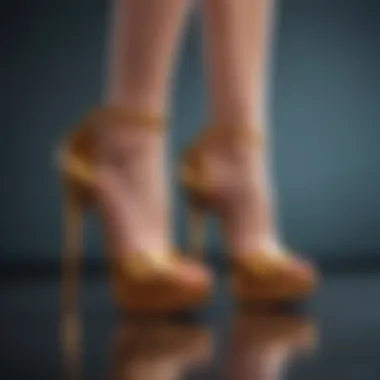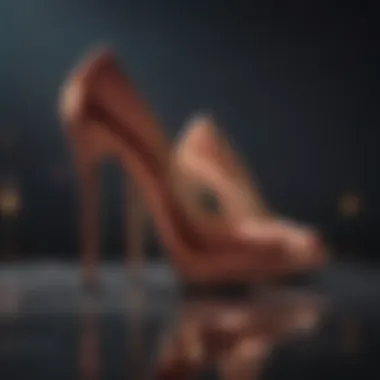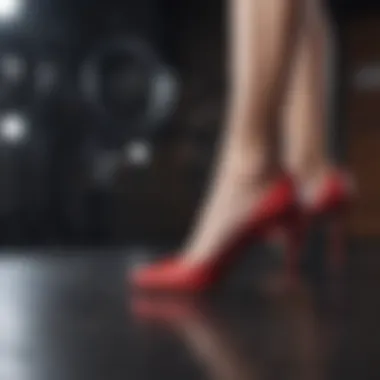The Art and Science of Comfy High Heels


Intro
In the quest for elegance, high heels hold a cherished yet complicated status. They can enhance posture, elongate legs, and serve as a statement of style. However, many women grapple with the discomfort that often accompanies this beloved footwear. This tension between aesthetics and comfort is complex but essential. Understanding how modern design can satisfy both needs is crucial.
The evolution of high heels spans centuries, evolving from practical footwear to symbols of status and sophistication. Innovations in ergonomic design and material technology now offer options that do not sacrifice comfort for style. This article unpacks those innovations, examining the confluence of art and science in creating truly comfortable high heels.
From proper shoe selection based on individual foot type to maintenance tips for longevity, the goal is to provide a comprehensive guide that empowers women. They should be able to make informed choices that align with their personal style without compromising on well-being.
With this foundation, we can explore the broader themes of fashion trends in high heels, including sustainable practices and street style inspirations.
Prologue to Comfy High Heels
High heels have long been a symbol of style and elegance, yet they often come with significant discomfort. The rising demand for comfortable high heels is a response to the common struggles women face with traditional designs. Comfort does not need to be sacrificed for the sake of aesthetics. This article will dissect the nature of comfy high heels, emphasizing the necessity of this balance.
Choosing comfortable high heels is an essential consideration for many women. The design and construction of footwear should prioritize foot health and overall well-being. When heels are constructed with comfort in mind, they can enhance the wearer’s experience rather than detract from it.
The main elements to discuss include the historical significance of high heels, the various types available, and the ergonomic design principles that play crucial roles in comfort. Each of these factors contributes to understanding how to blend style with practicality.
Moreover, the increased awareness around foot health further highlights the relevance of choosing high heels that are both fashionable and comfortable. The importance of comfort extends beyond aesthetic appeal; it influences physical health, productivity, and the overall happiness of the wearer. Therefore, understanding the art and science behind comfy high heels is imperative for making informed choices.
"The right pair of high heels can elevate not just your stature, but also your confidence and comfort."
Through this article, readers will gain insights into the features that make heels both stylish and comfortable. We will also delve into methods for selecting shoes based on individual foot types and preferences. This comprehensive guide aims to empower women of all ages to navigate the intricate terrains of footwear choices, enabling them to confidently embrace high heels without compromising comfort.
Understanding High Heels
Understanding high heels involves exploring their history and the various types available. This knowledge is essential for anyone looking to merge fashion with comfort. The evolution of high heels reflects changes in society and fashion norms. Knowing the historical context can inform current choices and preferences in footwear. Additionally, familiarizing oneself with the types of high heels aids in selecting the ideal pair for specific situations.
The Historical Context of High Heels
High heels have a rich history that dates back centuries. Initially worn by men, they signified power and stature. Over time, high heels transitioned into women's fashion, symbolizing femininity and elegance. The first documented instance of high heels dates to the 10th century with Persian cavalrymen. They needed elevated shoes to secure their feet in stirrups. By the 16th century, Catherine de' Medici popularized high heels among women in Europe.
Social and cultural influences have continuously shaped high heel styles. During the Victorian era, heels were often associated with the upper class. This attribution exacerbated the divide between social classes and cemented high heels as a marker of status. The development of various styles reflected changing attitudes toward women in society. Today, high heels still carry both aesthetic and social implications, making their understanding crucial for modern consumers.
Types of High Heels
High heels come in multiple styles, each providing a different aesthetic and comfort level. Recognizing these types can assist in making informed decisions.
Stilettos
Stilettos are renowned for their long, narrow heels typically ranging from 2 to 6 inches. Their sleek design enhances the leg's appearance but can lead to discomfort after prolonged wear.
- Key Characteristic: The slender heel provides an elegant, elongated look to the wearer.
- Benefit: Stilettos are an ideal choice for formal events and parties, emphasizing glamour.
- Disadvantage: Long periods in stilettos can lead to foot pain and other health issues.
Wedges
Wedges feature a more unique sole, lifting the heel incorporating a solid construction from the heel to the toe. This style offers stability and distributes weight more evenly.
- Key Characteristic: The design resembles a triangular shape, connecting the heel to the sole.
- Benefit: Wedges are comfortable for all-day wear, making them suitable for casual outings.
- Disadvantage: They may not suit formal occasions as effectively as other types.
Block Heels
Block heels feature a thick, wide heel providing substantial support. They strike a balance between height and stability, often regarded as comfortable.
- Key Characteristic: The broad base offers enhanced support compared to narrower heels.
- Benefit: Great for both casual and semi-formal settings, block heels can be worn for extended periods.
- Disadvantage: Some styles may lack the elegance associated with taller, thinner heels.
Kitten Heels
Kitten heels represent a lower heel option, generally ranging from 1.5 to 2 inches in height. They are best known for their subtle elegance and comfort.


- Key Characteristic: Their brief height offers a sophisticated option for those who prefer lower heels.
- Benefit: Suitable for both office wear and formal events, providing comfort without sacrificing style.
- Disadvantage: Some may find them less fashionable compared to higher heel options.
The Need for Comfort in High Heels
In the world of high heels, the focus often lands squarely on aesthetics, yet comfort serves as a foundational aspect that cannot be overlooked. The interplay between style and comfort represents a significant consideration when choosing footwear. High heels can elevate not only one's stature but also one's confidence. However, this elevation comes with a number of consequences if comfort is disregarded. Understanding the need for comfort in high heels is essential to fostering a harmonious relationship between elegance and well-being.
Impact of High Heels on Foot Health
High heels exert a multitude of impacts on the foot's health. The mechanisms through which these impacts manifest can be diverse and nuanced.
Pressure Points
Pressure points are areas on the foot that experience excessive weight under particular conditions. Wearing high heels can intensify this issue, leading to discomfort. Key characteristics of pressure points include their proximity to bony structures, which makes them susceptible to pain when constrained by footwear. In high heels, the distribution of weight shifts towards the forefoot, creating significant stress on these sensitive areas.
The unique feature of pressure points in high heels is that they highlight the necessity for proper design accommodating these areas. Proper cushioning and strategic arch support are critical in alleviating pressure. However, neglecting this aspect can lead to immediate and prolonged discomfort.
Foot Shape Alteration
Foot shape alteration involves changes in the natural form of the foot due to habitual high heel wear. The characteristic change is often a narrowing of the foot's shape, which can cause misalignment. This alteration is a popular topic within discussions of high heels because it underscores the tension between aesthetic appeal and personal health.
A notable aspect is that some wearers may adapt to high heels at the expense of their natural foot shape. The unique feature of this aspect is how long-term usage may lead to permanent alteration of foot structure. This can be particularly detrimental to comfort and overall health, necessitating careful consideration.
Long-Term Effects
Long-term effects encompass a range of outcomes that result from continued high heel usage. As these effects accumulate, they often complicate what initially seems like a benign choice. A key characteristic of long-term effects is that they often do not manifest immediately but rather become apparent after years of use.
One unique feature is how prolonged wearing leads to chronic pain conditions or even the development of foot deformities such as bunions or hammertoes. These deficiencies are remarkably common among frequent high heel wearers, illustrating the necessity for a balanced approach to luxury and comfort.
Psychological Effects of Footwear Comfort
The correlation between footwear comfort and psychological wellbeing is multifaceted. Comfort in shoes can enhance one's confidence and mood, ultimately affecting overall daily functioning. When a person feels comfortable, it fosters a sense of security and freedom of movement. Thus, it is vital to recognize that the benefits of comfortable high heels extend beyond the physical realm.
Factors such as confidence, self-esteem, and overall satisfaction can pivot dramatically based on the choice of footwear. When women select shoes that prioritize comfort alongside style, it can fundamentally change their experiences in social situations. The equation of comfort and style not only enhances the physical experience of wearing heels but also contributes favorably to mental well-being.
Ergonomic Design Principles
The concept of ergonomic design focuses on creating products that enhance comfort and efficiency. In the context of high heels, it means accounting for how the shoes interact with the wearer’s foot structure and walking mechanics. Proper ergonomic principles play a critical role in mitigating discomfort and preventing potential foot-related issues from extended wear.
Foot Support Mechanisms
Arch Support
Arch support is essential for maintaining the natural curvature of the foot. It helps distribute weight evenly across the foot, thus reducing strain on the arches. This feature is particularly important in high heels, where the elevation can exacerbate pressure on the foot.
One key characteristic of arch support is its ability to relieve pressure points. This is a significant draw for many women who face discomfort while wearing high heels. A well-designed arch support can enhance overall comfort by preventing foot fatigue during prolonged wear.
However, not all arch supports are created equal. Some designs are harder, which may cause discomfort for individuals with sensitive feet.
Cushioning Materials
Cushioning materials are integral to comfort in high heels. They absorb impact during walking, acting like a buffer between the foot and hard surfaces. The most common materials used include memory foam and gel cushioning, known for their ability to conform to the foot's shape.
This flexibility is a hallmark of effective cushioning material. It allows for dynamic support as the foot moves. Such materials are popular among brands focusing on comfort without sacrificing style.
On the downside, some cushioning can wear down quickly, leading to reduced effectiveness over time.
Toe Box Design
Toe box design refers to the shape and space at the front of the shoe, where the toes reside. A well-designed toe box promotes natural toe movement by providing enough space for the toes to splay comfortably. This is crucial, especially in high heels, where a cramped toe box can lead to various foot issues.


The key characteristic of an effective toe box is its width and depth. Comfy high heels tend to prioritize these aspects to ensure that the foot remains in a relaxed position.
However, sometimes a larger toe box can detract from the shoe's aesthetic or stability, which needs to be balanced.
Height and Angle Considerations
Choosing the appropriate height and angle for high heels is essential. Heels that are too high or angled awkwardly can lead to instability and discomfort. Ideally, the height should offer elevation without compromising balance.
Different occasions may call for varying heel heights, from lower wedges to taller stilettos. The key is to find a sweet spot that allows for both elegance and ease of wear.
Ultimately, when selecting high heels, considering ergonomic design principles can work wonders in enhancing comfort and style.
Selecting the Right Pair
Choosing the right pair of high heels is a crucial step in ensuring both style and comfort. Women often seek high heels that not only enhance their outfit but also offer support throughout the day. With various styles available, understanding personal foot characteristics can aid in making informed decisions. The right pair fits well and complements individual needs, minimizing discomfort and potential health risks associated with improper footwear.
Identifying Your Foot Type
Understanding your foot type provides insights into what high heel styles may work best for you. Feet come in different shapes, and recognizing these can help in selecting shoes that support your comfort and health.
Flat Feet
Flat feet are characterized by a low arch, meaning the entire sole comes into contact with the ground. Women with flat feet often face challenges with balance and support in high heels, making arch support essential. Choosing shoes with a firm midsole and a supportive insole can alleviate pain.
Key characteristics of flat feet include:
- Low or no arch
- Prone to overpronation
Flat feet may lead to discomfort if wearing traditional high heels. However, many brands offer styles designed specifically for this foot type, providing adequate arch support and cushioning.
High Arches
High arches create a curve where only a small portion of the foot touches the ground. This foot structure can lead to pressure on specific foot areas when wearing high heels. Selecting shoes with extra cushioning can help distribute this pressure evenly, reducing discomfort during extended wear.
Key characteristics of high arches include:
- A prominent curve on the foot
- Less contact with the ground
For women with high arches, high heels that offer ample toe box space and good shock absorption are often more comfortable.
Narrow Feet
Narrow feet pose a unique challenge in finding shoes that fit properly. Often, high heels are too wide in the toe box for this foot type, leading to slipperiness or instability. Opting for brands known for sizing specificity can provide a solution, creating a better fit.
Key characteristics of narrow feet include:
- Less width across the arch and toe box
- Often struggle with slipping shoes
Choosing styles that feature adjustable straps or narrow fits helps maintain support while walking.
Wide Feet
Women with wide feet benefit from shoes designed for a broader fit. This means selecting high heels that provide adequate space across the toe box and arch area. Shoes with flexible materials are often preferable, as they conform better to the foot’s shape.
Key characteristics of wide feet include:
- Greater width across the foot
- Need for additional space in shoes
Wide feet may face discomfort in standard high heels, making it essential to pick options with a wider fit or specifically labeled for this foot type.


Choosing by Occasion
When selecting high heels, it's necessary to consider the occasion to ensure that comfort aligns with style. Casual events can often allow for more playful designs, while formal events may require elegant, structured heels. Always think about the environment, duration of wear, and personal comfort level when making selections.
Balancing Style and Functionality
Balancing style and functionality in high heels is vital for a confident appearance. Look for pairs that incorporate both fashionable elements and supportive features. Understanding foot type helps in narrowing options that meet these dual needs, ultimately empowering women to embrace elegance and comfort without compromise.
Popular Brands Focused on Comfort
The topic of popular brands focused on comfort is essential in the discussion of high heels. Comfort in high heels is not merely a luxury; it is a necessity for many women who seek both style and practicality. Brands have recognized the high demand for comfortable footwear options and have developed innovative designs and technologies to address this need. Understanding these brands and their contributions can help women make informed choices when selecting high heels.
Overview of Key Players in the Market
Brand A
Brand A has made significant contributions to the realm of comfortable high heels. This brand is known for its emphasis on ergonomic design. One key characteristic of Brand A is its use of memory foam insoles. This feature provides exceptional cushioning, which enhances comfort during prolonged wear. The unique technology within these insoles adapts to the foot's shape, which can help in minimizing pressure points and fatigue. This makes Brand A a popular choice among consumers who want elegance without sacrificing comfort. However, one disadvantage is that the foam can wear out faster than other materials, necessitating more frequent replacements.
Brand B
Brand B stands out for its stylish yet functional designs. The brand focuses on marrying aesthetics with comfort, making their shoes not only appealing but also supportive. A notable feature of Brand B is the incorporation of arch support into their heel design. This support plays a crucial role in maintaining foot health, particularly for those who spend long hours on their feet. Brand B's shoes tend to fit a variety of foot shapes well, which can lead to greater satisfaction among wearers. However, some consumers may find that they run slightly narrow, which could be a point of consideration for those with wider feet.
Brand
Brand C is a frontrunner in comfort technology. Known for its innovative materials, Brand C utilizes breathable fabrics and lightweight structures in its high heels. One key characteristic is the padded straps that offer added comfort and stability. The unique selling point of Brand C’s designs is their versatility, allowing for easy transitions from professional settings to casual outings. While Brand C excels in comfort and style, a potential disadvantage is their higher price point, which might deter budget-conscious consumers.
Innovations in Comfort Technology
In recent years, the high heel industry has seen an influx of innovations focused on comfort technology. These innovations include advanced cushioning systems, moisture-wicking materials, and customizable fit options. Brands have begun to explore multi-layered cushioning techniques that combine different densities for improved comfort. Furthermore, some brands offer the ability for customers to adjust their heel height or fit, improving the overall experience of wearing high heels. These advancements not only enhance comfort but also support foot health, making wearing heels less of a compromise.
"Comfort is not just about how a shoe feels; it’s about how it supports the foot over time."
Care and Maintenance of High Heels
Caring for and maintaining high heels is as essential as selecting the right pair to wear. Regular care ensures the shoes not only last longer but also remain comfortable and visually appealing. Many women invest significantly in their footwear, making it crucial to prioritize upkeep. Ignoring maintenance can lead to premature wear, reduced comfort, and a diminished aesthetic appeal. Therefore, understanding the proper care protocols can contribute significantly to extending the life of high heels.
Cleaning Techniques
Cleaning high heels requires gentle yet effective techniques to preserve their materials and finish. Here are some considerations:
- Material Matters: Different materials need different care. For leather heels, a soft cloth and specialized leather cleaner can maintain their shine. On the other hand, fabric heels may require dedicated upholstery cleaners.
- Stains and Scuffs: For minor stains, a damp cloth with a small amount of soap can often suffice. For scuffs, using a pencil eraser may help remove marks without damaging the finish.
- Regular Maintenance: It is beneficial to clean high heels after each wear, especially if they have been exposed to dirt or salt. This prevents buildup that can lead to stains.
- Deep Cleaning: For more intensive cleaning, consider professional services. These experts understand different materials and can provide the best treatment without causing harm.
"Good maintenance preserves the elegance of your high heels and can increase their lifespan significantly."
Storage Solutions
Proper storage is another critical aspect of maintaining high heels. Storing them correctly helps avoid unnecessary damage. Here are some tips for effective storage:
- Use Shoe Boxes: Whenever possible, keep your high heels in their original boxes. This protects them from dust and potential damage. Consider labeling the boxes for quick identification.
- Shoe Trees: Inserting shoe trees can help maintain the shape of your heels. They absorb moisture and prevent deformity from being squished.
- Avoid Direct Sunlight: Store your footwear away from direct sunlight as exposure can fade colors and damage some materials.
- Keep Away from Heat: High heels should also be kept away from heat sources. Heat can warp the materials and compromise their structure.
- Regular Checks: Periodically check your stored heels to ensure no wear or pest issues, especially if they have been stored for a long time.
By incorporating these cleaning and storage techniques, women can ensure that their high heels remain in optimal condition. With proper care, even the most delicate pairs can stay beautiful and comfortable for many occasions.
Culmination
In summation, the exploration of comfy high heels presents a nuanced understanding of the fine balance between style and comfort. High heels have traditionally been seen through a lens of beauty and elegance, often at the expense of comfort. This article illustrates that it does not have to be one or the other.
The journey through this topic underscores several key points. First, knowing one's foot type is fundamental when selecting high heels. Comfort is not universal; it varies from person to person. A pair that feels cozy for one individual might not suit another. Therefore, identifying your unique foot type allows for a more personalized approach to shopping.
Moreover, the importance of ergonomic design cannot be overlooked. Features such as proper arch support, adequate cushioning, and toe box design are essential for long-term comfort. These elements significantly contribute to how a shoe fits and feels over time, thus enhancing overall foot health. By focusing on these design principles, brands can create high heels that are both fashionable and functional.
Additionally, brands focused on comfort are taking significant steps to innovate. These advancements in technology are reshaping how high heels are designed. They show a commitment to improving customer experience by prioritizing comfort alongside style.
Care and maintenance of high heels also play a crucial role in their longevity and comfort. Proper cleaning techniques and suitable storage solutions can protect the investment made in quality footwear.
Ultimately, understanding how to choose and care for comfy high heels empowers women. It equips them with the knowledge to make informed decisions, ensuring footwear can be a source of confidence without causing physical distress. In today's world, embracing both comfort and elegance is not merely a desire but a necessity. Women can, and should, enjoy the art of high heels without compromising on their well-being.



